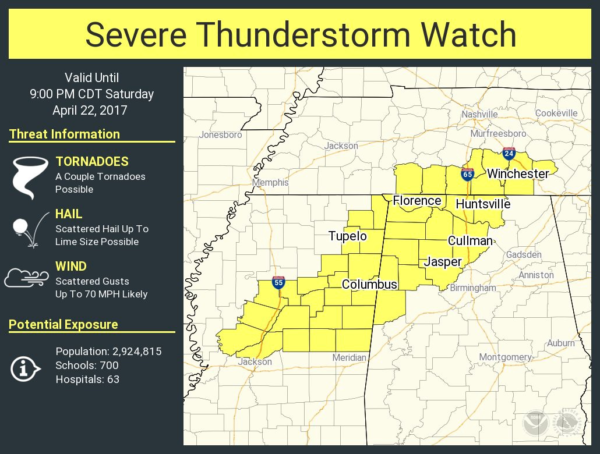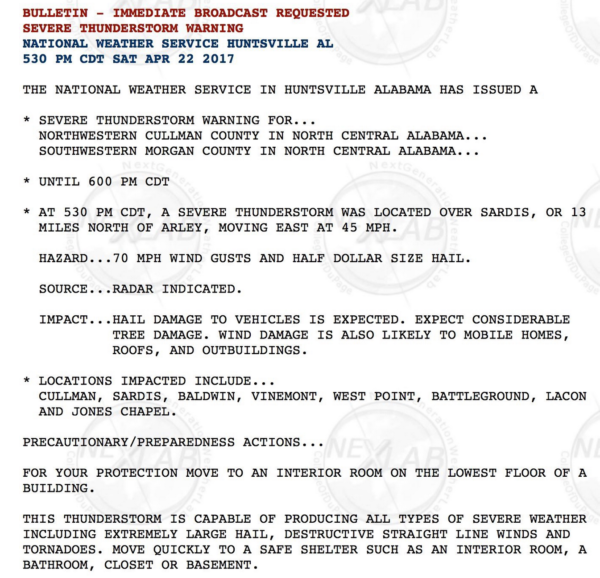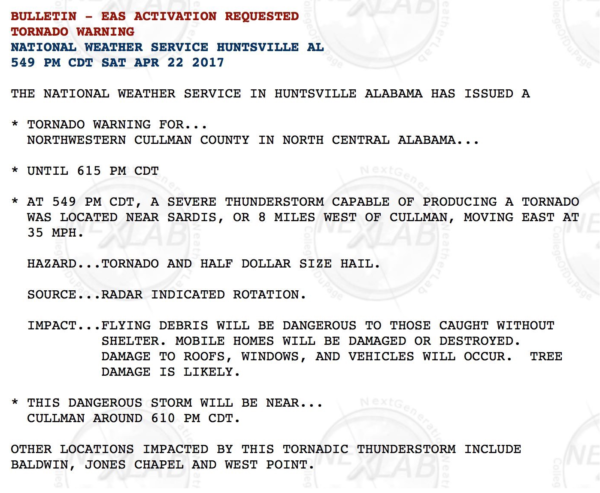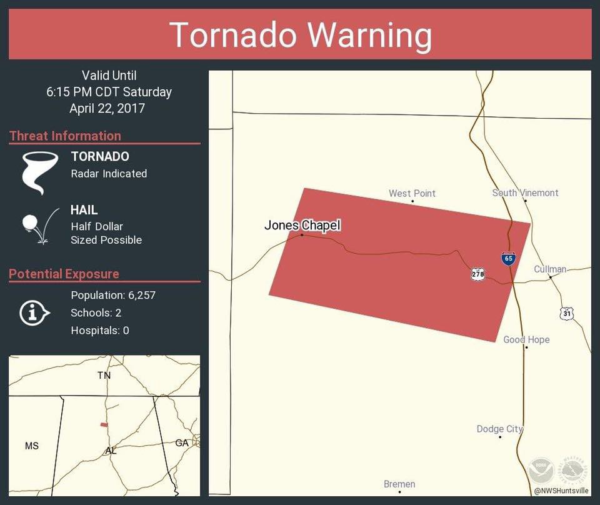The Severe Weather Warning Process… We All Have Work To Do
By James Spann
(posted from medium.com/@spann)
A small, short-lived tornado touched down in western Cullman County Saturday evening producing damage, but thankfully no injuries. It presents an extremely interesting case study in physical science, and social science. The bottom line is we all have much work to do.
Let’s first look at issues within the professional weather community.
In the days leading up to the event, it was clearly forecast that severe storms would be possible across the northern half of Alabama. However, the primary threats forecast were hail and strong straight line winds, not tornadoes. In multiple blog discussions, I indicated that the risk of a tornado was “very, very low”. The Storm Prediction Center issued a severe thunderstorm watch, as opposed to a tornado watch earlier that afternoon based on the idea that meteorological parameters did not favor tornado formation.
As it turned out… There were two small tornadoes during the event, the one in Cullman County, and an EF-0 in Franklin County. This is a reminder that we have much to learn about tornadogenesis and severe local convective storms. There is much work to do.
Concerning the watch/warning process… A severe thunderstorm watch was issued for much of North and West Alabama at 3 o’clock that afternoon.
This was almost three hours before the damage occurred in Cullman County.
The first warning was issued at 5:30; A severe thunderstorm warning that covered Jones Chapel and the western part of Cullman County. Within the text of that warning… It indicated that the thunderstorm was capable of producing all types of severe weather, including destructive winds, large hail, and a tornado.
This warning came 10 minutes before the tornado first touchdown near Jones Chapel at 5:40. The warning aired immediately on ABC 33/40 with a crawl complete with the full text. It was also distributed across all of my social media feeds, including Facebook and Twitter.
Those with a NOAA weather radio, and a good warning app on their phone, should have received it as well.
When a tight velocity couplet appeared on radar… a tornado warning was issued at 5:49. This warning came while the tornado was on the ground, and six minutes before it dissipated.
We went into long form weather coverage on ABC 33/40 within seconds of the time the tornado warning was issued. It was distributed across all other platforms as well.
The screaming message here is the simple fact that providing early warning for a very small, short-lived tornado is very difficult, and in many cases impossible. We are very good with longer lead times for strong/violent tornadoes that are responsible for most deaths.
For EF-0/EF-1 tornadoes, they often last for just a matter of minutes. By the time a signature shows up on radar and a warning is issued and disseminated, the damage is done and the tornado has lifted. We must do a better job of communicating this limitation in the warning process. And, we must do a better job of reminding people that you have to take severe thunderstorm warnings seriously, and you need to read the text within the warning.
Yes, in the weather enterprise we clearly have much work to do. But, considering the current limitations of our knowledge, I thought the NWS did an exemplary job in issuing watches and warnings Saturday. but, this day needs to be reviewed from a meteorological perspective so we all can do better next time.
“I didn’t get any warning”
I have heard this message many times since the event on Saturday. I will be the first to say the tornado warning was late. but, the severe thunderstorm warning was issued 10 minutes before the damage started. And many people report not hearing either warning.
This is where social science comes in to play; I would love to hear social scientists chime in on this issue. But these are my observations…
Siren dependency. Let me make this perfectly clear… Sirens do serve a purpose in the warning process. But please understand, they are a last resort. They reach a limited number of people outside; they have never, ever been effective in reaching anyone inside a home, business, or church. You might hear a siren on a bright sunny day; but hearing one in the middle of the night during a raging storm when you are asleep will never happen. Way too many Alabamians use siren systems as their primary way of getting severe weather warnings. This siren mentality has killed countless people in our state over the years.
The lack of understanding of storm based, polygon warnings. About 10 years ago… the warning system changed. Tornadoes, even large ones, impact only a relatively small area, and there is no need to warn an entire county. Warnings are issued for just segments of counties, defined by a polygon. This is where the term “respect the polygon” comes from. People in the city of Cullman reported no sirens and no notification on their smart phone app (for those using a modern warning app that uses the polygon warning system)
Notice the actual tornado warning below. Most of the City of Cullman was not in the warning, so sirens there should not have sounded, and there should have been no smart phone notifications.
That was a very well drawn polygon… And there was no damage in the city of Cullman.
We must do a better job of letting people know that warnings do not cover entire counties; only small parts of counties.
Perceived rural bias. I heard some people saying if this storm would have been in the (Birmingham) metropolitan area, the warnings would have been better. That is as far from the truth as it gets. Anyone that has heard me speak over the last six years has heard me say that every life is precious, where do you live in the city or out in the country.
I can prove it by showing you the piles of hate messages I have received when doing wall-to-wall tornado coverage on ABC 33/40 for places like Haleyville, Cullman, Eastaboga, and Aliceville. These nasty messages come from people in larger cities angry because they could not watch regular programming due to the tornado coverage for rural areas.
Scroll anytime through my social media feeds, or the blog. Every county, all people are treated the same in my market.
Bottom line: People should have multiple ways of getting severe weather warnings, and they should pay attention to severe thunderstorm warnings. The baseline for every home and business is a NOAA Weather Radio. Are they perfect? No. In fact weather radios are still based on the old county warning system from years gone by. But they are very loud and will wake you up in the middle of the night if there is a warning.
The second tier is a good smart phone app designed for warning dissemination. There are literally over a thousand weather apps in the app store on your phone; most of those will not warn you in a timely fashion during severe weather.
The app I recommend for warnings is WeatherRadio by WDT. Trust me, I have no financial interest in this app, and I geut no kickbacks. It just works very well. I use it, my family uses it. You might see a few negative comments on this app… That is from people that don’t understand how the polygon warning system works. If you are in a warning polygon, you get the notification. If you were not in the polygon, you get nothing. It works amazingly well.
We have to take a deep breath, and realize we ALL have work to do to make the severe weather warning process better, let’s use this event as a learning lesson…
Category: ALL POSTS, Met 101/Weather History




















Comments (37)
Trackback URL | Comments RSS Feed
Sites That Link to this Post